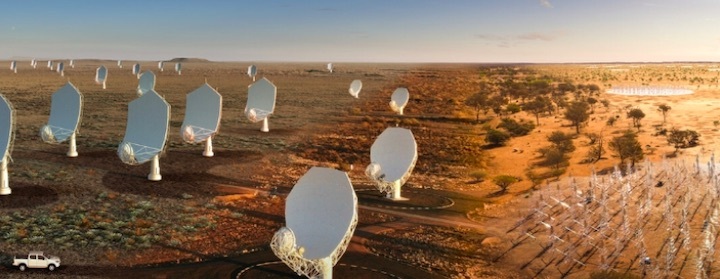1.02.2023

Canada has officially announced its intention to join as a partner in the Square Kilometre Array Observatory. The announcement formalizes Canada’s long involvement in Square Kilometre Array Observatory, and provides a variety of benefits for Canadian astronomers peering into the distant past of the Universe.
The Square Kilometre Array Observatory (SKAO) is the realization of a long-theorized project to study how the universe evolved in its earliest days at the Cosmic Dawn, and what that means for fundamental questions in astrophysics.
As the SKAO website explains, early stars and galaxies are “exceptionally faint,” and the most useful information comes from studying (for example) the ionization of early hydrogen particles from light photons. No single radio telescope could manage this, no matter how large, and in the 1980s scientists began devising a kind of telescope that actually could manage the job.
They determined that studying these questions would require not one telescope, but an enormous array of telescopes, at least a square kilometre in size. In fact, it would require more than one of these arrays, due to the different wavelengths of radio that each array would need to study.
That gave rise to the SKAO concept, and a decades-long campaign to realize the construction of these immense arrays. In 2012, sites at locations in Australia and South Africa were selected, and a permanent headquarters was established in the United Kingdom. The SKA Observatory Convention was established in 2019, and construction activities started in 2021. Seven countries signed onto the convention: Australia, China, Italy, the Netherlands, Portugal, South Africa and the United Kingdom.
Though Canada was not an initial signatory, Canada has been contributing to the project for a while. Even before the announcement of official partnership, the National Research Council (NRC) announced a cooperation agreement in late 2021, saying that Canada would be helping with the project as the Government decided on official partnership.
At the time, NRC President Iain Stewart said that “we are pleased to continue collaboration with our international partners on this transformative science facility” and that SKAO will “open doors for ground-breaking discoveries by Canadian astronomers.” The NRC also said that “Canadian astronomers have identified access to the SKA as a top priority in their decadal long-range plans in 2000, 2010 and 2020,” and that “scientists from across Canada participate in nearly all SKAO science working groups.”
Canada’s principal contribution has been building one of the “brains” of the arrays. The arrays will generate immense amounts of data, and as the data is “faint and buried in noise,” it will take equally immense computing power to process. Canadian data-processing technology in the form of a “digital correlator,” made by NRC’s Herzberg Astronomy and Astrophysics Research Centre and their industry partner MDA, is being used in processing data for the South African array.
The SKAO’s announcement of the partnership said that the Herzberg Centre “has been identified to represent Canada in the governance of the SKAO and will work with domestic and international partners to deliver key observatory systems. This includes the digital correlator, the all-important ‘brain’ behind the SKA-Mid telescope in South Africa.”
In return, the announcement identified that Canada will receive several benefits for its contributions. Canada will be entitled to a 6 percent use-share of the observatory, “access to a next generation radio astronomy facility” and support for “the establishment of a domestic regional centre. This centre will provide direct connections to data collected with the telescope as well as science support to enable ground-breaking discoveries.”
The SKAO site’s location page provides further information on the centres, saying that “a global network of SKA Regional Centres (SRCs) in Member States will provide portals to data products, platforms/forums for advanced scientific analysis, and user support and training for astronomers using data collected by the SKA telescopes. The SRCs will operate as a fully integrated network to ensure that all SKA users are able to access data products and the tools to analyse them.”
In the announcement, Minister of Innovation, Science and Industry François-Philippe Champagne said that the partnership will “solidify our scientific expertise and ensure Canada stays at the leading edge of astronomy and astrophysics,” adding that “Canadian contributions to the SKAO could lead to new opportunities for Canadian businesses and, more so, for our scientists.” NRC President Stewart said that the SKAO will “enable transformational science about the Universe, the fundamental laws of physics and the prospects for life beyond our Solar System,” and that Canada’s membership will “maximize Canada’s recognized capabilities in astronomy and scientific computing platforms.”
The announcement didn’t go into details on next steps, however, only saying “the official signing ceremony and other steps necessary to complete the membership process are anticipated to take place in the coming months.” Inquiries into details on the process and the timeline were made with NRC, but they weren’t able any details in time for publication.
Editor’s note: We’ve updated the title of the story to reflect that Canada has decided to officially join the SKAO. However, Canada must participate in the process for membership and members still need to vote to accept Canada.
Quelle: spaceQ
